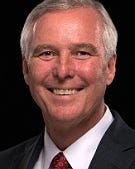The company has big strategic and operating priorities for 2020.

Adding thousands of on-net fiber buildings per quarter has been a big priority for CenturyLink, and that velocity will continue through 2020.
That’s what CEO Jeff Storey said during this week’s Citi 2020 Global TMT West Conference in Las Vegas. The company’s strategic and operating priorities for 2020 include transforming the products and services it sells, and how the business operates, recognizing that telecommunications is always changing, he said.

CenturyLink’s Jeff Storey
“We continue to invest in making sure we have edge technology available,” he said. “We look at our network and today we have something north of 90% of American businesses within five milliseconds of our network, so how do we continue to expand that footprint, how do we make that even shorter time periods? Because we think that’s going to matter more and more in the future than it does today. And we also want to strategically continue to invest in our network.”
CenturyLink‘s competitive advantage is “wherever our fiber is,” Storey said.
“If you look throughout the United States, we have certainly very rich long-haul networks with many conduits available so that we can continue to expand the network for years to come without having to build new trenches and dig new trenches,” he said. “In the United States, we have very dense metro fiber networks and continue to expand that. In the first quarter we added about 4,500 new buildings, second quarter about 5,000 and third quarter about 5,000, so we’re adding 4,500-5,000 new buildings every quarter. That gives us a competitive advantage to continue to take fiber directly to the customer.”
CenturyLink has about 150,000 buildings on net and its target is “north of 200,000,” Storey said.
“There’s plenty of opportunity, and we look at buildings from a couple of different perspectives,” he said. “We rarely build it and hope they will come. That’s just not a great strategy, especially when you already have 150,000 buildings in place. And when you sell as much as we do, we know where we pay off-net expenses and that’s one of the first filters that we look at, where are we paying other carriers to deliver our services to customers. We target those buildings because we can convert that, save the expense and provide a better experience when we’re 100% on-net with a customer. It gives us better control of the network itself, and how do we guarantee redundancy and survivability for the customer.”
CenturyLink also has the benefit of looking at all of the incoming requests for new services, and so “we target and have plenty of opportunity to continue to expand the building footprint,” Storey said.
“And we have to do a really good job once we have the building, converting the off-net expense to on-net and continuing to sell to all the new customers in the building,” he said. “If you look at legacy CenturyLink footprint, we’ve got a great SMB business within the legacy footprint. Level 3 never focused on those customers. And so we have a lot of buildings outside the legacy CenturyLink footprint where we’ve got great SMB customers, but we really haven’t ever penetrated. So how do we go to those buildings, how do we offer products and services to all of the customers … located in that building.”
In terms of addressable market for products and services, Storey said CenturyLink’s MPLS-SD-WAN market share should be higher, “we should be selling faster and more of them, but we’re very pleased with it.”
“There’s a lot of upside from our addressable market, and frankly I look at every part of our business, whether it starts with dark fiber, or a security application that sits on top of things, and think we have a lot of opportunity to grow and a lot of opportunity to go out and be more successful than we are,” he said. “It’s competitive market, every single one of our products you can buy from multiple competitors and our value comes in that we just do things better.”
Read more about:
AgentsAbout the Author(s)
You May Also Like


